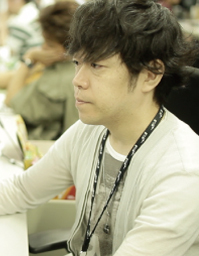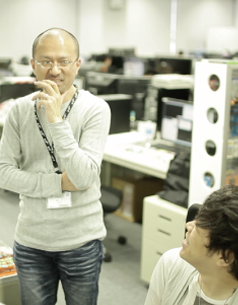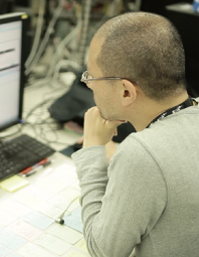Individuality in Game Development
Hidetoshi Kai (Graphic Design/Animation) and Hiroshi Shibata (Game Design)
PlatinumGames is entering its 10th year, but some of our staff members have careers in the game industry that go back over two decades. Two such members are animator Hidetoshi Kai and game designer Shibata, who can trace their roots all the way back to the 4th Development Division at Capcom. These two veterans, who made the jump to Platinum together with director Hideki Kamiya and producer Atsushi Inaba, talk about their experience and thoughts on game development.
Skills gained through Trial and Error
Kai: The formative experience that led me to video games took place back in kindergarten. A little candy shop I went to had a couple of Pachinko and pinball machines that I loved to play with. My dad is a carpenter, and he would use nails and scraps of wood he found around the house to make little Pachinko boards. Even back then I loved thinking up games. My parents didn’t buy me many toys, so I got used to making them myself.
Shibata: My family moved to Tokyo around the time the Famicom (the Japanese equivalent of the Nintendo Enterainment System) came out, but we were very poor so I didn’t get a chance to play games much as a kid. In fact, I didn’t buy a Famicom until I started working at a game company. I was making do with nothing more than a TV, refrigerator, and rice cooker back then; I didn’t have the money to buy a lot of electrical appliances, let alone to buy any for recreational purposes.
Kai: I was a little late to the video game party, too. I didn’t even consider working at a game company until after I had entered a vocational school. There, I studied film and other visual media. I worked with cameras a lot, and I specifically studied animation as a form of expression.

Shibata: I studied animation at a vocational school, just like Kai. I wanted to make a living in animation, but it was just not a viable way to pay the bills. The first job I started out of school was in the printing industry, but the pay was bad, so my life of poverty continued… A friend of mine worked at a game company though, and he told me the money was good, so I decided to get into the game industry. In other words, I wasn’t trying to fulfill a romantic dream of making games, as much as I saw the game industry as a solution to my financial woes.
Kai: Yeah, I hear the animation industry can be pretty rough. We have a couple of people who decided to quit their jobs at an animation company in order to join us.
Shibata: Although, in a way, your current job actually still involves animation.
Kai: That’s right. I’m in charge of creating the animations that dictate how the characters move. I sometimes animate environments as well.
Shibata: My job is to think of ideas that make the game more interesting – I get to say whatever pops up in my head, haha. Officially, I’m responsible for writing up game proposals and design documents to coordinate the direction of the team with each section, but working under Kamiya means I often don’t prepare any documents. Why is that you ask? Because with Kamiya at the helm, the game changes so frequently that by the time you get everything on paper, the document will already be obsolete, haha.

Kai: Maybe so, but I still think you make more documents than most other people.
Shibata: I guess so, haha. Anyway, I originally entered this industry as a graphic designer just like you, Kai, and I remember that I used to have a lot of fun creating sprites using pixel graphics. This meant having to line up every little square of color that would be displayed on the player’s screen, but we could only use 16 colors back then, so I would spend hours obsessively trying to figure out how to line up all of the dots to create the image I wanted.
Kai: Yeah, it was a neat way to make graphics. I still feel like doing work like that sometimes, haha.
Shibata: It has a certain addictiveness different from regular drawing. Capcom’s pixel art from that era was incredible, but it had a strange quirk: although pixels are usually square, Capcom was unique in that they used vertically rectangular pixels. This meant that even rotating the sprite on its side required you to replace all the pixels. It was highly inefficient, but they still managed to put out many uniquely beautiful sprite-based games. I decided that, “If I’m going to be a sprite artist, it’s Capcom or nothing”, so I moved to the Kansai area where Capcom’s headquarters are located.
Kai: You came all the way to the Kansai area for sprites?!
Shibata: Oh yeah, it was great! Soon after I entered the company I was assigned to a team developing arcade games and I got to ram out rectangular sprites to my heart’s content.
Kai: I started out in Capcom’s console game department. In many cases, the pixels for console games were horizontally rectangular, so this made porting arcade games to consoles an absolute nightmare.
Shibata: But you know, thinking back to it now, I realize that when we first got into development, in the days when the images on screen contained nothing but the most rudimentary information, games ended up being extremely refined. There is a lot of fluff in modern games, so making games now ends up being a lot harder than the days of yore. There are so many more rules you have to learn nowadays.
Kai: Yeah, things are still tough, just in a different way now. How about you, though? How did you end up making the jump from a pixel-laying graphic designer to a game designer?
Shibata: Well, one thing I realized while working at Capcom was that beautiful graphics alone aren’t enough to sell a game. The art in Capcom’s games was among the best in the entire industry, but this never guaranteed that their titles would be successful. It became painfully clear to me that art isn’t the most important aspect of a game, so I decided to focus on thinking up original ideas.

Kai: Although I entered the company as a graphic designer, I actually wanted to make games more than I wanted to work on their graphic design. I always had my eyes open for opportunities to try different aspects of development. I’ve even done stuff like making up questions for quiz games and burning ROMs. Leaving behind the pixel painting lifestyle, I manipulate polygons now. Although the job title has remained the same, the knowledge and skills required have changed quite a bit.
Shibata: You can say that again. The stuff I learned about at vocational school was very different from what the game industry required, so I had to learn about things as I was making them. When 3D polygon models came onto the scene, it was an entirely new experience altogether. Capcom as a whole was slow to get onto the polygon bandwagon, and everyone working there was a beginner when it came to making 3D games. We couldn’t fight progress, however, so we just had to do our best to keep up.
Kai: The youngsters entering the company right out of college nowadays are better prepared than we were. Hardware back then was changing so hectically all the time that we had to just try out all kinds of different things and see what worked. As a result, though, I think we learned a lot about perseverance and determination.
(Continues to Part 2.)
interview by editorial studio MUESUM (2012/08/03)